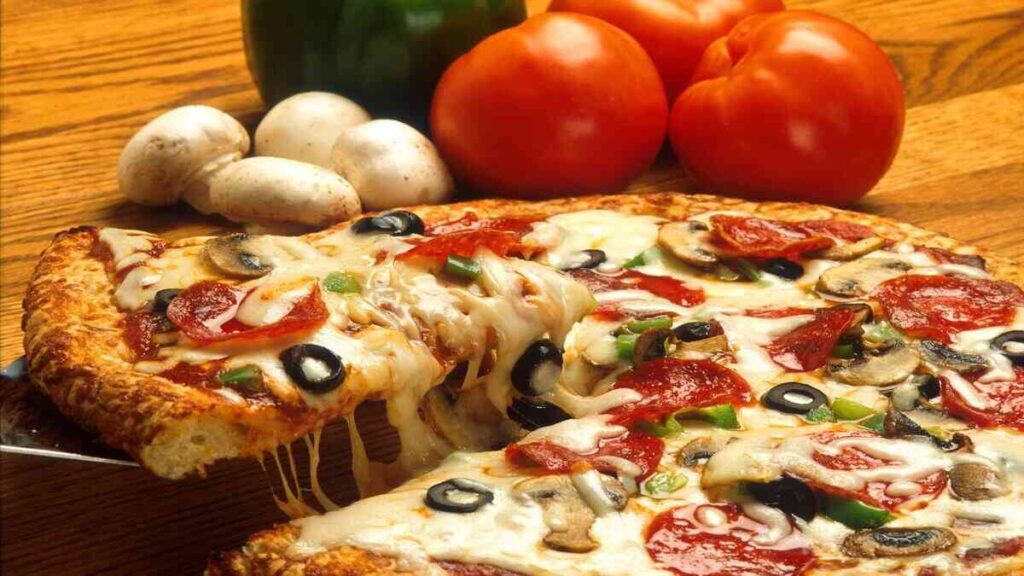When it comes to pizza, few styles are as iconic and universally beloved as New York pizza. Known for its thin crust, rich flavors, and perfect foldability, New York pizza Recipe has become a culinary symbol not just in the United States, but around the world. Whether you’re a local New Yorker or a curious foodie, let’s dive into what makes New York pizza truly special, where to find the best slices, and why it continues to reign supreme.

Outline
- Introduction
- Importance of New York pizza Recipe in global food culture
- What defines a classic New York pizza
- History of New York Pizza Recipe
- Origins and how it came to the U.S.
- Evolution of the iconic style
- Key Characteristics of New York Pizza Recipe
- Thin crust
- Sauce and toppings
- Foldable slice
- Why New York Pizza Recipe Stands Out
- Unique ingredients
- Baking techniques
- The NYC water factor
- Where to Find the Best New York Pizza
- Iconic pizzerias (e.g., Lombardi’s, Di Fara)
- Hidden gems and local favorites
What Makes New York Pizza Unique?
A Slice of History: The Origins of New York Pizza Recipe
New York pizza traces its roots back to Italian immigrants in the early 20th century. The first pizzeria, Lombardi’s, opened in 1905 in Manhattan’s Little Italy. These pioneers brought traditional Neapolitan pizza recipes, but adapted them to American tastes, creating a larger, thinner, and more portable version. Over the decades, New York pizza has evolved while maintaining its authentic charm.
Defining Features of New York Pizza Recipe
1. The Thin Crust
The thin, crispy crust of New York pizza is its most defining feature. Made with high-gluten flour, the dough achieves a perfect balance of crunch and chewiness. It’s sturdy enough to support toppings but thin enough to fold – a true hallmark of NYC slices.
2. Sauce and Toppings
New York pizza uses a simple yet flavorful tomato sauce, often made with San Marzano tomatoes. The cheese, typically mozzarella, is generously layered to create that gooey, satisfying stretch. Classic toppings include pepperoni, mushrooms, and sausage, but you’ll find everything from truffle oil to vegan cheese in modern iterations.
3. Foldability
A true New Yorker knows the only way to eat a slice is to fold it. This isn’t just for practicality – the fold helps contain the pizza’s rich flavors, ensuring every bite is as delicious as the first.
The Secret to Its Excellence
1. NYC Water: The Magic Ingredient
Many pizza makers swear that New York’s tap water plays a crucial role in the dough’s flavor and texture. The unique mineral content of the water helps create the perfect crust, which is hard to replicate elsewhere.
2. Traditional Baking Techniques
New York pizza is typically cooked in coal or gas ovens, which provide high, consistent heat. This gives the crust its signature char while melting the cheese to perfection.
3. Quality Ingredients
From fresh mozzarella to authentic olive oil, the best pizzerias prioritize high-quality ingredients. This dedication to excellence ensures that each bite is packed with flavor.
Top Spots for New York Pizza Recipe
1. Lombardi’s
The original pizzeria, Lombardi’s, still serves some of the best pizza in the city. Their coal-fired oven produces a crust with a smoky, irresistible flavor.
2. Di Fara Pizza
Located in Brooklyn, Di Fara is a pilgrimage site for pizza lovers. Each pie is crafted with love by Domenico DeMarco, who uses imported Italian ingredients.
3. Joe’s Pizza
A favorite among locals and tourists alike, Joe’s Pizza in Greenwich Village is a classic spot for a perfect slice.
4. Prince Street Pizza Recipe
Known for its thick, square slices topped with crispy pepperoni, Prince Street Pizza is a modern classic in the world of New York pizza.
5. Artichoke Basille’s Pizza Recipe
For those looking to try something unique, Artichoke Basille’s offers creamy, artichoke-topped pizza that’s a departure from tradition but equally delicious.
How to Enjoy New York Pizza Like a Local

- Fold Your Slice
It’s not just tradition; it’s functional. Folding prevents the cheese and sauce from sliding off and makes eating on the go much easier. - Pair It with a Soda
Classic New York slices are often enjoyed with an ice-cold soda, balancing the pizza’s rich flavors. - Skip the Fork and Knife
Real New Yorkers know that pizza is a finger food. Dive in, get a little messy, and savor the experience.
New York Pizza Recipe Beyond NYC
New York pizza’s popularity has led to its spread across the globe. Many pizzerias outside of NYC attempt to recreate the style, but only a handful come close. Authentic New York pizza is hard to replicate, thanks to its unique water and traditional techniques.
Why You’ll Fall in Love with New York Pizza Recipe
New York pizza isn’t just food – it’s an experience. Whether you’re savoring a slice on a park bench or grabbing a late-night bite with friends, it brings people together. Its rich history, perfect crust, and diverse toppings make it a culinary masterpiece that’s worth celebrating.
Conclusion
New York pizza is more than a dish; it’s a cultural icon that represents the spirit and flavor of NYC. From its humble beginnings in Little Italy to its status as a global phenomenon, New York pizza continues to win hearts (and stomachs) everywhere. If you’ve never had a slice, it’s time to grab one and join the love affair.
FAQs
1. What makes New York pizza different from other styles?
New York pizza stands out for its thin crust, foldability, and simple yet flavorful toppings.
2. Can I make New York pizza at home?
While replicating NYC’s water and ovens is tough, you can create a close approximation with high-gluten flour and quality ingredients.
3. What is the best topping for New York pizza?
Classic toppings like pepperoni and mushrooms are popular, but the best topping is whatever you love most!
4. Where can I find authentic New York pizza outside NYC?
Some pizzerias in other cities specialize in New York-style pizza, but nothing beats enjoying a slice in the Big Apple itself.
5. Is New York pizza healthy?
Like all pizza, it’s best enjoyed in moderation. That said, its thin crust often makes it a lighter option compared to deep-dish or stuffed-crust styles.
